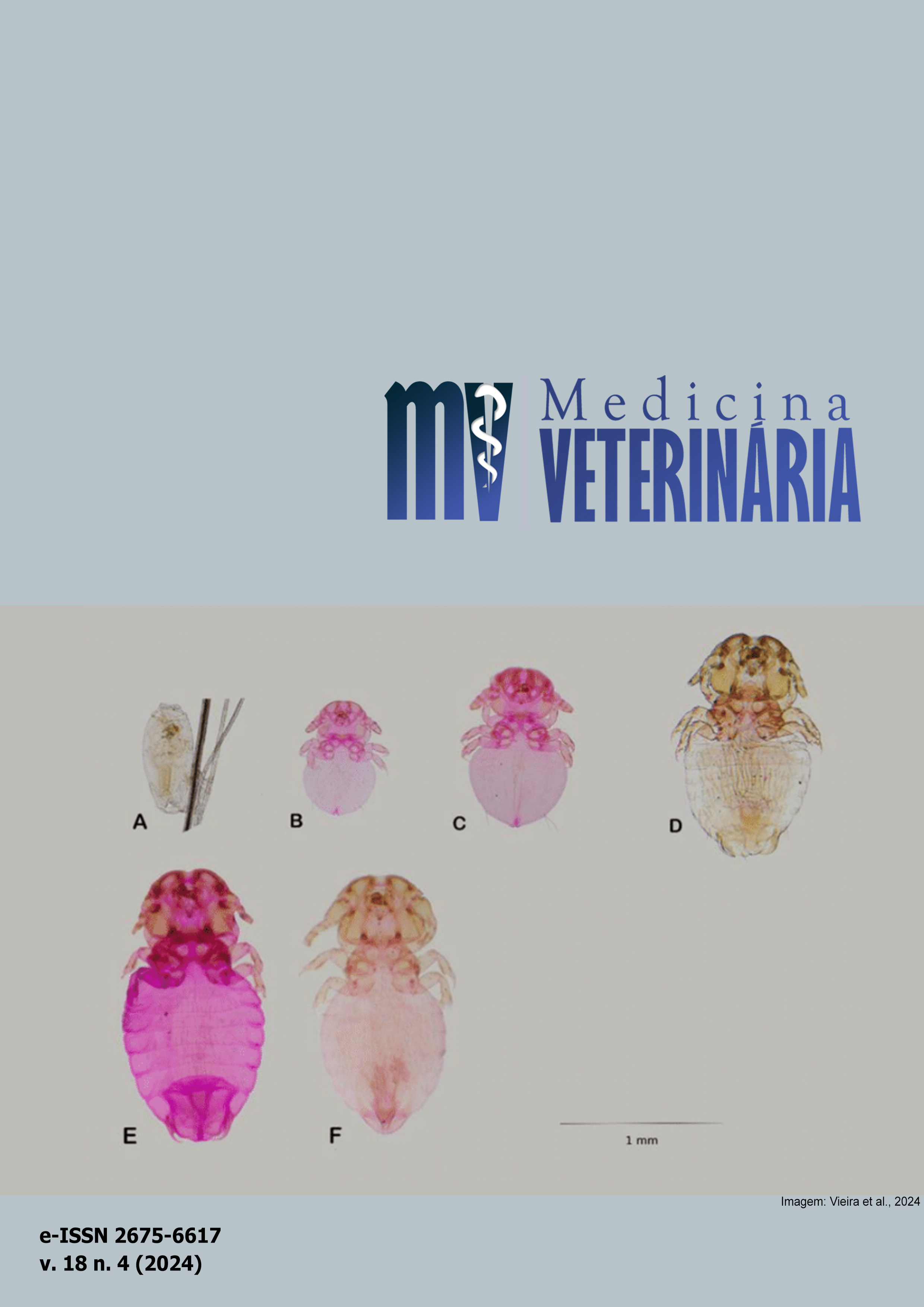Lucilia cuprina maggots in the treatment of necrotic lesion in cat after the use of ectoparasiticide
DOI:
https://doi.org/10.26605/medvet-v18n4-6843Keywords:
biotherapy, Calliphoridae, wound healing, Felis catus, larval therapyAbstract
With the emergence of multidrug-resistant microorganisms, the healing of infected wounds has been the subject of constant research. In this context, various alternative therapies have been employed, and biotherapy, although ancient, still faces barriers to its use and lacks information, especially regarding the effects of the Lucilia cuprina species. Therefore, we aimed to report, for the first time, larval therapy using larvae of this species in the healing of necrotic lesions in a domestic cat, following the use of an ectoparasiticide. The feline with an extensive necrotic lesion, piossanguinolent secretion, and myiasis by Cochliomyia hominivorax on the face, was treated with L. cuprina larvae after using an ectoparasiticide. The treatment was performed in conjunction with other therapies, where it was observed that the patient showed excellent recovery and that the use of L. cuprina larvae was effective in assisting wound healing. The therapy proved to be safe for use in animals, preserving healthy tissues, and thus contributes to the resolution of new clinical cases and the number of fly species that can be used in larval therapy in Brazil.Downloads
References
Alves, D.F.S.; Cabral Júnior, F.C.; Cabral, P.P.A.C.; Oliveira Junior, R.M.; Rego, A.C.M.; Medeiros, A.C. Efeitos da aplicação tópica do mel de Melipona subnitida em feridas infectadas de ratos. Revista do Colégio Brasileiro de Cirurgiões, 35(3): 188–193, 2008.
Dillmann, J.B.; Lopes, T.R.R.; Rosa, G.; Fracasso, M.; Barraza, V.C.T.; Barbosa, N.V.; Andrade, C.M.; Kommers, G.D.; Cargnelutti, J.F.; Monteiro, S.G. Safety and efficacy of Lucilia cuprina maggots on treating an induced infected wound in Wistar rats. Experimental Parasitology, 240: 108337, 2022.
Franco, L.C.; Franco, W.C.; Barros, S.B.L.; Araújo, C.M.; Rezende, H.H.A. Aceitabilidade da terapia larval no tratamento de feridas. Revista Recien - Revista Científica de Enfermagem, 6(17): 13–18, 2016.
Furman, D.P.; Catts, E.P. Manual of Medical Entomology. Cambridge: University Press, 1982. 207p.
Gomes, L.; Von Zuben, C.J. Dispersão larval radial pós-alimentar em Lucilia cuprina (Diptera, Calliphoridae): profundidade, peso e
distância de enterramento para pupação. Iheringia, Série Zoologia, 94(2): 135-138, 2004.
Haddad, M.C.L.; Bruschi, L.C.; Martins, E.A.P. Influência do açúcar no processo de cicatrização de incisões cirúrgicas infectadas. Revista Latino-Americana de Enfermagem, 8(1): 57-65, 2000.
Hall, M.J.R.; Wall, R. Myiasis of Humans and Domestic Animals. Advances in Parasitology, 35, 257-334, 1995.
Hanzel, B.E.; Sperotto, R.L. Larval therapy, a literature review. Brazilian Journal of Development, 7(7): 69039–69044, 2021.
Jourdan, M. Larval therapy. International Journal of Clinical Practice, 61(3): 359-360, 2007.
Kerridge, A.; Lappin-Scott, H.; Stevens, J.R. Antibacterial properties of larval secretions of the blowfly, Lucilia sericata. Medical and Veterinary Entomology, 19 (3): 333–337, 2005.
Kung, H.J.; Kuria, S.K.; Villet, M.H.; Mkhizem J.N.; Dhaffala, A.; Iisa, J.M. Cutaneous Myiasis: Is Lucilia cuprina Safe and Acceptable for Maggot Debridement Therapy? Journal of Cosmetics, Dermatological Sciences and Applications, 2: 79-82, 2012.
Machado, M.L.S.; Rodrigues, E.M.P. Emprego do Nitenpyram como larvicida em miíases caninas por Cochliomyia hominivorax. Acta Scientiae Veterinariae, 30(1): 59–62, 2018.
Marques, S.R.; Peixoto, C.A.; Messias, J.B.; Albuquerque, A.R.; Silva Jr, V.A. The effects of topical application of sunflower-seed oil on open wound healing in lambs. Acta Cirúrgica Brasileira, 19(3): 196-209, 2004.
Masiero, F.S.; Aguiar, E.S.V.; Pereira, D.I.B.; Thyssen, P.J.; Foley, J. First Report on the Use of Larvae of Cochliomyia macellaria (Diptera: Calliphoridae) for Wound Treatment in Veterinary Practice. Journal of Medical Entomology, 20: 1-4, 2019a.
Masiero, F.S.; Silva, D.G.; Luchese, M.; Estércio, T.; Pérsio, N.V.; Thyssen, P.J. In vitro evaluation of the association of medicinal larvae (Insecta, Diptera, Calliphoridae) and topical agents conventionally used for the treatment of wounds. Acta Tropica, 190: 68-72, 2019b.
Paul, A.G.; Ahmad, N.W.; Lee, H.L.; Ariff, A.M.; Saranum, M.; Naicker, A.S.; Osman, Z. Maggot debridement therapy with Lucilia cuprina: a comparison with conventional debridement in diabetic foot ulcers. International Wound Journal, 6(1): 39-46, 2009.
Serafini, G.M.C.; Schossler, J.E.W.; Amaral, A.S.; Dutra, L.H.; Dibi, A.P.; Drogemoller, P.; Athayde, C.L. Granulated sugar and sugar gel in treating canine wounds. Ciência Rural, 42(12): 2213-2218, 2012.
Sherman, R.; Hall, M.J.R.; Thomas, S. Medical Maggots: an Ancient Remedy for some Contemporary Afflictions. Annual Reviews Entomology, 45: 55-81, 2000.
Sherman, R.A. Maggot therapy takes us back to the future of wound care: new and improved maggot therapy for the 21st century. Journal of Diabetes Science and Technology, 3(2): 336–344, 2009.
Stevens, J.; Wall, R. Species, sub-species and hybrid populations of the blowflies Lucilia cuprina and Lucilia sericata (Diptera: Calliphoridae). Proceedings of the Royal Society B: Biological Sciences, 263: 1335–1341, 1996.
Turkmen, A.; Graham, K.; Mcgrouther, D.A. Therapeutic applications of the larvae for wound debridement. Journal of Plastic, Reconstructive & Aesthetic Surgery, 63(1): 184-188, 2010.
Downloads
Published
How to Cite
Issue
Section
License
Copyright (c) 2024 Julia Somavilla Lignon, Everton Dorneles Machado, Daniel Roulim Stainki, Silvia Gonzalez Monteiro

This work is licensed under a Creative Commons Attribution-NonCommercial-ShareAlike 4.0 International License.
A Revista de Medicina Veterinária permite que o autor retenha os direitos de publicação sem restrições, utilizando para tal a licença Creative Commons CC BY-NC-SA 4.0.
De acordo com os termos seguintes:
Atribuição — Você deve dar o crédito apropriado, prover um link para a licença e indicar se mudanças foram feitas. Você deve fazê-lo em qualquer circunstância razoável, mas de nenhuma maneira que sugira que o licenciante apoia você ou o seu uso.
NãoComercial — Você não pode usar o material para fins comerciais.
CompartilhaIgual — Se você remixar, transformar, ou criar a partir do material, tem de distribuir as suas contribuições sob a mesma licença que o original.
Sem restrições adicionais — Você não pode aplicar termos jurídicos ou medidas de caráter tecnológico que restrinjam legalmente outros de fazerem algo que a licença permita.







